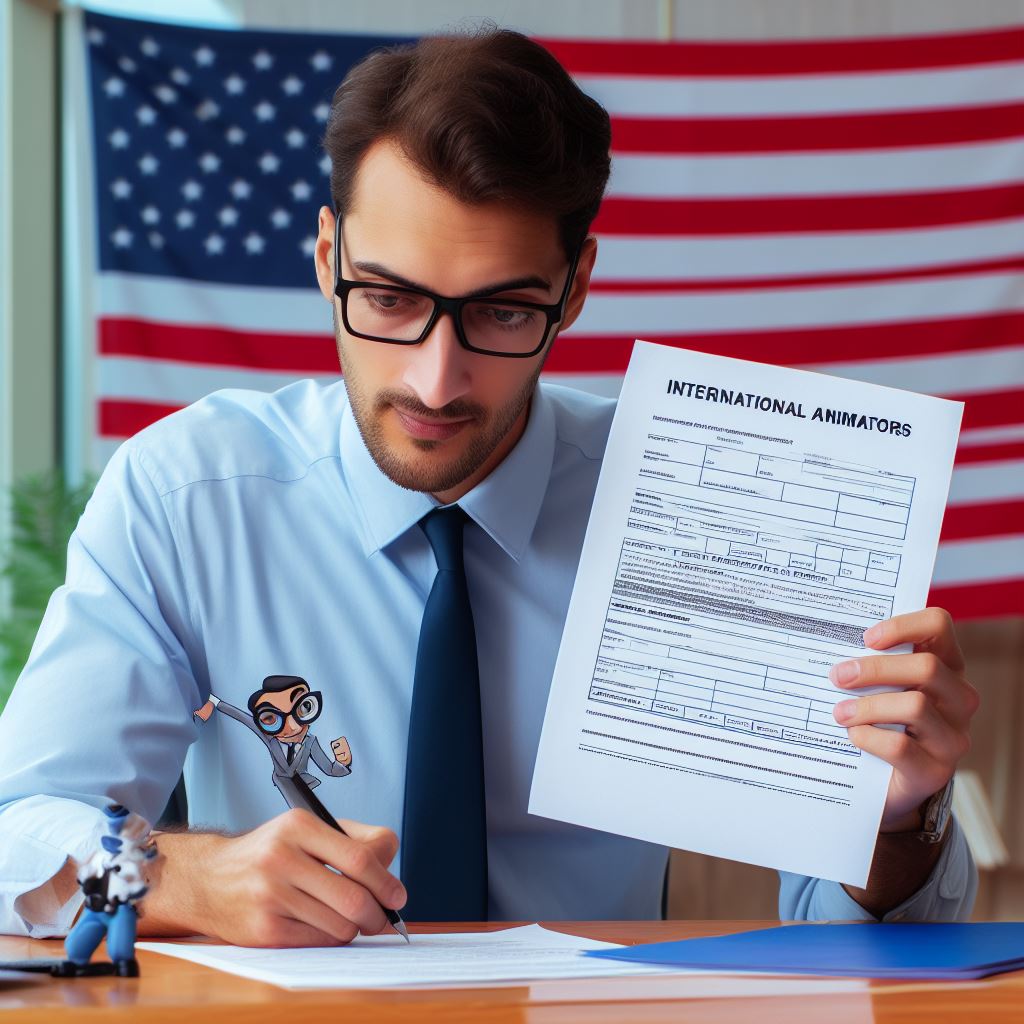Introduction
The Importance of Work Visas for International Animators in the USA
Navigating work visas is vital for international animators aiming to contribute their talents to the dynamic American animation industry.
Capture the Attention of the Readers by Highlighting the Opportunities Available in the American Animation Industry
The American animation industry, a global powerhouse, offers international animators unparalleled opportunities to showcase their creativity and skills.
Securing a work visa is the gateway to accessing these opportunities, allowing foreign animators to become integral parts of renowned studios and production houses.
As we delve into the complexities of work visas, this section will provide insights into the specific requirements, processes, and nuances that international animators must understand.
The allure of contributing to blockbuster films, innovative TV series, and cutting-edge digital projects motivates animators worldwide to explore the pathways to work legally in the USA.
The American animation industry welcomes diversity and fresh perspectives, and work visas are the keys that unlock doors to collaborations with industry giants.
International animators bring unique cultural influences and artistic approaches, enriching the industry’s tapestry and pushing the boundaries of creative expression.
In the following sections, we’ll guide you through the intricacies of visa categories, application procedures, and essential tips for a successful transition to working in the USA.
For animators aspiring to make their mark on the global stage, understanding the nuances of work visas is not just a legal requirement but a strategic step toward fulfilling their dreams in the heart of the American animation scene.
General Overview of Work Visas
Definition what a work visa is and its purpose
A work visa is a document issued by a country’s government that allows foreign individuals to work within that country.
It serves the purpose of regulating the entry and employment of foreign professionals in order to meet specific labor market needs.
Mention the different types of work visas available for foreign professionals
- H-1B Visa
- O-1 Visa
- L-1 Visa
- E Visa
- TN Visa
- J-1 Visa
Brief explanation of the requirements and application process for work visas
- H-1B Visa: Requires sponsorship by a U.S. employer and meeting specific educational and professional qualifications.
Application process involves filing a petition and going through a lottery system due to high demand. - O-1 Visa: Requires demonstrating extraordinary ability in the field of animation and receiving sponsorship.
Application process involves submitting evidence of achievements and expertise in the field. - L-1 Visa: Requires being transferred by an employer to the U.S. branch or subsidiary.
Application process involves proving the existence of a qualifying relationship between the foreign and U.S. entities. - E Visa: Requires individuals from treaty countries to engage in trade or investment activities.
Application process involves providing evidence of substantial trade or investment between the home country and the U.S. - TN Visa: Requires being a citizen of Canada or Mexico and meeting specific professional qualifications.
Application process involves presenting a job offer from a U.S. employer and providing supporting documentation. - J-1 Visa: Requires being sponsored by an exchange program approved by the U.S. Department of State.
Application process involves obtaining a DS-2019 form and complying with the program’s regulations.
Read: Future of Artistry: Digital Trends Shaping the US Art World
Specific Work Visas for International Animators
Most Common Work Visas Used by International Animators in the USA
- H-1B Visa: Allows skilled foreign workers, including animators, to work temporarily in the USA.
- O-1 Visa: Provides extraordinary ability individuals, such as exceptional animators, the opportunity to work in the USA.
- L-1 Visa: Enables companies to transfer international animators from their foreign offices to their US branches.
Eligibility Criteria for Each Specific Visa Option
H-1B Visa
- Applicant must have a bachelor’s degree or equivalent experience in the field.
- The job position must be a specialty occupation, requiring specialized skills.
- The employer must offer a prevailing wage to the animators.
O-1 Visa
- Animators must demonstrate extraordinary ability in their field through awards, recognition, or extensive experience.
- They must have a job offer or an agent willing to represent them in the USA.
L-1 Visa
- Animators must have worked for the same employer or its affiliated company abroad for at least one year.
- The animators should be transferred to work as managers, executives or individuals with specialized knowledge.
Benefits and Limitations of Each Visa Category
H-1B Visa
Benefits
- Allows animators to work for a specific employer in the USA for up to 6 years.
- Enables animators to bring their immediate family members as dependents.
- Offers a pathway to obtaining permanent residency (Green Card) in the future.
Limitations
- Only a limited number of H-1B visas are available each year, subject to an annual cap.
- The application process can be lengthy and complex, requiring significant paperwork.
- Job positions must meet specific requirements to be considered specialty occupations.
O-1 Visa
Benefits
- Allows animators to work in the USA for an initial period of up to 3 years, with extensions possible.
- Provides flexibility to work for different employers or projects without requiring visa sponsorship each time.
Limitations
- Requires animators to demonstrate extraordinary ability, which can be subjective and challenging.
- Application process may involve substantial documentation and evidence to prove exceptionalism.
L-1 Visa
Benefits
- Allows companies to transfer experienced animators to their US branches seamlessly.
- Enables animators to work in the USA for an initial period of up to 3 years, extendable to a maximum of 7 years.
Limitations
- Only available to animators working for multinational companies with affiliated offices abroad.
- Does not provide a direct path to permanent residency (Green Card) in the USA.
Considering your specific circumstances and objectives, choosing the right work visa option is crucial.
It is recommended to consult an immigration attorney to navigate the complex visa application process successfully.
Remember, each visa category has its own requirements, advantages, and limitations. Understanding these factors is essential for international animators seeking work opportunities in the USA.
Read: Behind the Canvas: Day-to-Day Life of a US-Based Artist

H-1B Visa for Skilled Workers in Specialty Occupations
The H-1B visa program facilitates skilled international workers in specialty occupations, making it popular for professionals, including animators.
To qualify, animators need a relevant bachelor’s degree and a job offer from a sponsoring US employer.
Real-life examples of successful H-1B applications for animators include:
- John, a Canadian animator with a bachelor’s degree, received sponsorship from a Los Angeles studio.
- Maria, a Brazilian animator with a master’s degree, secured sponsorship from a New York City company.
- Chen, a Chinese animator with a bachelor’s degree, got sponsorship from a San Francisco studio.
These animators contribute to the US animation industry, showcasing the program’s significance for international professionals.
Transform Your Career Today
Unlock a personalized career strategy that drives real results. Get tailored advice and a roadmap designed just for you.
Start NowBy meeting the necessary qualifications and obtaining a job offer from a US employer, animators can successfully apply for the H-1B visa and pursue their careers in the thriving US animation industry.
Read: US Art Taxation: Financial Tips and Deductions for Artists
O-1 Visa for Extraordinary Ability in the Arts
The O-1 visa category and its requirements
- The O-1 visa is a non-immigrant visa category in the United States.
- It is designed for individuals with extraordinary ability in various fields, including the arts.
- To qualify for an O-1 visa, applicants must demonstrate exceptional achievements and recognition in their field.
- The visa category is divided into two subcategories: O-1A for scientists, educators, business professionals, and O-1B for artists and entertainers.
- O-1 visa applicants in the arts must provide evidence of their extraordinary ability in their specific discipline.
How international animators can demonstrate their extraordinary abilities
- International animators can demonstrate their extraordinary abilities through various means.
- They can showcase their artistic portfolio, highlighting their innovative and distinctive style.
- Awards and accolades received for their work in the animation industry can be valuable evidence.
- Professional memberships, invitations to exhibit or present at prestigious events, and critical reviews can all contribute to demonstrating extraordinary ability.
- Collaborations with renowned artists or production companies also serve as evidence of exceptional talent.
Success stories of international animators who obtained O-1 visas
- Juan Martinez, a Mexican animator, was granted an O-1 visa based on his significant contributions to the animation industry.
- Martinez’s animations had won numerous international awards, and he was recognized as a pioneer in 3D animation techniques.
- Maria Kim, a Korean animator, secured an O-1 visa by showcasing her unique storytelling skills and moving character animations.
- Kim had worked with renowned studios and had her animations featured in prestigious film festivals.
- Ricardo Silva, a Brazilian animator, obtained an O-1 visa after his animations gained worldwide acclaim for their emotional depth and visual aesthetics.
- Silva’s ability to convey complex narratives through compelling visuals was considered extraordinary.
In review, the O-1 visa category offers international animators an opportunity to showcase their extraordinary abilities in the United States.
To obtain an O-1 visa, animators must provide evidence of their exceptional accomplishments, awards, recognition, and contributions to the field.
Examples of successful international animators who obtained O-1 visas demonstrate the effectiveness of this visa category in attracting and retaining top talent in the animation industry.
Read: Strategies for US Artists to Break Into the Global Scene
See Related Content: Collaborating with Developers in Game Design
J-1 Visa for Cultural Exchange Programs
Introduce the J-1 visa option for animators interested in cultural exchange programs
For international animators seeking work opportunities in the United States, the J-1 visa offers an exciting avenue through cultural exchange programs.
This visa category allows animators to immerse themselves in American culture while honing their skills in a professional setting.
The benefits and limitations of the J-1 visa category for animators
The J-1 visa provides numerous benefits for animators, such as the opportunity to gain valuable work experience in the U.S. animation industry.
Animators can develop their skills, learn about the latest technologies, and network with industry professionals. Additionally, they can experience American culture firsthand, expanding their horizons.
However, it is important to note the limitations of the J-1 visa. One major limitation is that the visa is temporary and usually granted for a specific program duration.
Animators must return to their home countries upon completion of the program, which may disrupt long-term job prospects in the U.S.
Furthermore, the J-1 visa may require animators to have a sponsoring organization or company, making the application process more complex.
Additionally, they must demonstrate their intention to return to their home country after the program ends, which can be challenging.
Examples of cultural exchange programs available for animators in the USA
Several cultural exchange programs in the USA cater specifically to animators, providing them with opportunities to enhance their skills while immersing themselves in American culture.
Some notable programs include:
- The Disney Cultural Exchange Program: This program offers international animators the chance to work at Walt Disney World Resort or Disneyland Resort while attending cultural workshops and events.
- The Internship USA Program: Managed by the U.S. Department of State, this program brings animators to American companies for training and work experience while promoting cultural exchange.
- The CIEE Internship Program: This program provides animators with internships in various U.S. cities, allowing them to work alongside professionals in the animation industry while exploring American culture.
- The Arts Intern Program: Designed for animators and other artists, this program offers internships at museums and cultural institutions, enabling participants to interact with the American art scene.
These cultural exchange programs not only provide animators with invaluable work experience but also allow them to make lasting connections with industry professionals and fellow artists from around the world.
To sum it up, the J-1 visa category for animators interested in cultural exchange programs presents a wonderful opportunity to gain professional experience, expand horizons, and experience American culture.
Showcase Your Business Today
Reach thousands of readers actively exploring professional services. Publish your business profile and grow your audience now.
Publish NowWhile there are limitations to consider, the benefits can greatly outweigh them.
Animators can participate in various programs tailored to their interests, bringing them closer to their dreams of working in the vibrant U.S. animation industry.
Other Work Visa Options for International Animators
Briefly mention other work visa options that may be applicable to animators
- H-1B Visa: A non-immigrant visa that allows U.S. companies to hire foreign professionals in specialized fields, including animation.
- L-1 Visa: Available for intracompany transfers, where international animators can work for a U.S. branch of their company.
- E-3 Visa: Specifically for Australian citizens, this visa allows animators to work in specialty occupations in the U.S.
- O-1 Visa: Intended for individuals with extraordinary ability or achievement in animation, this visa requires strong credentials and reputation.
Requirements and benefits of these additional visa categories
Each of these visa categories comes with its own set of requirements and benefits:
H-1B Visa
To qualify for an H-1B visa, animators must have a bachelor’s degree or equivalent in animation or a related field.
The sponsoring employer must also demonstrate that the position requires specialized knowledge and skills. H-1B visas are usually valid for up to three years, with the possibility of extension.
L-1 Visa
For animators employed by international animation studios with a branch or subsidiary in the U.S., the L-1 visa allows for intra-company transfers.
The animator must have worked for the company for at least one continuous year. The L-1 visa can initially be granted for up to three years, with extensions up to a total of seven years.
E-3 Visa
Australian animators looking to work in the U.S. can apply for an E-3 visa. Apart from having a job offer from a U.S. employer, applicants must possess specialized skills and qualifications relevant to animation.
The E-3 visa is renewable indefinitely in two-year increments and also allows spouses to work in the U.S.
O-1 Visa
The O-1 visa is suitable for internationally acclaimed animators who have demonstrated extraordinary ability in their field.
This visa requires extensive documentation to prove exceptional achievements, such as awards, published work, or recognition by industry experts.
O-1 visas are granted for an initial period of up to three years and can be extended.
Encouraging readers to consult an immigration attorney for personalized advice
While this section provides a brief overview of other work visa options for international animators, it is important to remember that individual circumstances may vary.
Consulting with an experienced immigration attorney is highly recommended to navigate the complexities of the U.S. immigration system and receive personalized advice tailored to your situation.
An immigration attorney can assess your qualifications, guide you through the application process, and help maximize your chances of obtaining a work visa suitable for your animation career in the United States.
Their expertise and knowledge in immigration law can significantly contribute to a successful visa application.
Remember, working legally in the U.S. as an international animator can open doors to exciting career opportunities and a thriving professional journey.
Take the necessary steps, explore all available work visa options, and embark on a rewarding animation adventure in the USA!
Conclusion
Summarize Key Points Discussed in the Blog Post
Navigating work visas is crucial for international animators aspiring to kickstart their careers in the USA.
Understanding the various visa options, such as the H-1B and O-1 visas, provides a clear pathway for foreign animators.
The Importance of Understanding Work Visas to Pursue Animation Careers in the USA
The intricate process of securing work visas directly impacts the ability of international animators to contribute to the dynamic animation landscape in the United States.
Clear comprehension of visa requirements ensures a smoother transition into the U.S. job market, fostering professional growth and development.
Encouraging Readers to Explore Their Visa Options and Take Proactive Steps Towards Achieving Their Career Goals
For aspiring animators, exploring available visa options and taking proactive steps is essential. Research, consult legal professionals, and plan accordingly.
Embarking on an animation career in the USA is an exciting prospect, and understanding the intricacies of work visas opens doors to international artists.
In closing, seize the opportunities that align with your career goals, navigate the visa landscape strategically, and embark on a fulfilling animation journey in the United States.
[E-Books for Sale]
The Big Book of 500 High-Paying Jobs in America: Unlock Your Earning Potential
$19.99 • 500 High-Paying Jobs • 330 pages
Explore 500 high-paying jobs in America and learn how to boost your career, earn more, and achieve success!
See All 500 High-Paying Jobs of this E-Book
1001 Professions Without a Degree: High-Paying American Jobs You Can Start Now
$19.99 • 1001 Professions Without a Degree • 174 pages
Discover 1001 high-paying jobs without a degree! Unlock career tips, skills, and success strategies for just $19.99!




